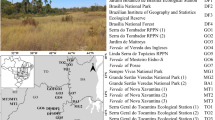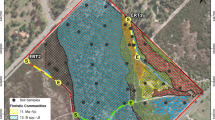Abstract
Soil chemistry can play an important role in determining plant diversity. Serpentine soils are usually toxic to many plant taxa, which limits plant diversity compared to that on adjacent non-serpentine soils. The usually high concentrations of toxic metals in serpentine soils are considered to be the edaphic factors that cause low diversity and high endemism. This paper aimed primarily to determine whether there is a relationship between serpentine soil chemistry and species richness on the Witwatersrand and to compare species richness of the serpentine areas with that of adjacent non-serpentine areas as well as with the species richness of the serpentine areas in the Barberton Greenstone Belt. The alpha- and beta-diversity of the Witwatersrand serpentine and non-serpentine areas was also investigated. A secondary aim of this study was to determine which of the non-serpentine taxa were more common on the serpentine than off the serpentine, which taxa were more common off the serpentine than on the serpentine and which taxa were equally common on and off serpentine soils. There was no significant difference in alpha-diversity between the serpentine and the adjacent non-serpentine areas, but beta-diversity is higher between serpentine plots than between non-serpentine plots. Although soil factors do affect species richness and diversity of plants on the Witwatersrand to a limited extent, the concentrations of soil chemicals in serpentine soils are not sufficiently different from those in non-serpentine soils to significantly influence the species richness and diversity of the serpentine soils. The high, but similar, diversity on serpentine and non-serpentine soils on the Witwatersrand indicates that soil factors do not play a significant role in determining diversity on potentially toxic soils in the area.




Similar content being viewed by others
References
Acocks JPH (1988) Veld types of South Africa. Mem Bot Surv S Afr 57:1–146
Balkwill K, Botany II 1993 (1995) Does fire or method of analysis affect the distribution of trees in different habitats? Trees South Africa XLIV(1–4):9–16
Balkwill K, Williamson SD, Kidger CL et al (1995) Diversity and Conservation of serpentine sites in southern Mpumalanga (Eastern Transvaal), South Africa. ORSTOM Noumèa, Doc Sci Tech III(6):133–138
Batianoff GN, Specht RL (1992) Queensland (Australia) serpentine vegetation. In: Baker AJM, Proctor J, Reeves RD (eds) The vegetation of ultramafic (serpentine) soils. Intercept, Hampshire
Berazain IR (1992) A note on plant/soil relationships in the cuban serpentine flora. In: Baker AJM, Proctor J, Reeves RD (eds) The vegetation of ultramafic (serpentine) soils. Intercept, Hampshire
Bredenkamp GJ, van Rooyen N (1996) Rocky Highveld Grassland. In: Low AB, Rebelo AG (eds) Vegetation of South Africa. Lesotho and Swaziland, Department of Environmental Affairs and Tourism, Pretoria
Brooks RR (1987) Serpentine and its vegetation—a multidisciplinary approach. Croom Helm, London & Sydney
Brower JE, Zar JE (1984) Field and laboratory methods for general ecology. Wm. C Brown Publishers, Iowa
Changwe K, Balkwill K (2003) Floristics of the Dunbar Valley serpentinite site, Songimvelo Game Reserve, South Africa. Bot J Linn Soc 143:271–285. doi:10.1046/j.1095-8339.2003.00228.x
Cowling RM (1990) Diversity components in a species rich area of the Cape Floristic Region. J Veg Sci 1:699–710. doi:10.2307/3235578
Cowling RM, Gibbs Russell GE, Hoffman MT et al (1989) Patterns of plant species diversity in southern Africa. In: Huntley BJ (ed) Biotic diversity in South Africa: concepts and conservation. Oxford University Press, Cape Town
Cowling RM, Holmes PM, Rebelo AG (1992) Plant diversity and endemism. In: Cowling RM (ed) The ecology of Fynbos: nutrients, fire and diversity. Oxford University Press, Cape Town
Dell CJ, Williams MA, Rice CW (2005) Partitioning of nitrogen over five growing seasons in tall grass prairie. Ecology 86(5):1280–1287. doi:10.1890/03-0790
Dörgeloh WG (1999) Diversity of the herbaceous layer in mixed bushveld. J Range Manage 52:519–524. doi:10.2307/4003781
Ellery WN, Scholes RJ, Mentis MT (1991) An initial approach to predicting the sensitivity of South African grassland biome to climate change. S Afr J Sci 87:499–503
Esler K, Cowling RM (1993) Edaphic factors and competition as determinants of pattern in South African Karoo vegetation. S Afr J Bot 59(3):287–295
Gaston KJ (1996) Species richness: measure and measurement. In: Gaston KJ (ed) Biodiversity: a biology of numbers and difference. Blackwell Scientific Ltd, Oxford
Goldblatt P (1978) An analysis of the flora of southern Africa: its characteristics, relationships, and origins. Ann Mo Bot Gard 65:369–436. doi:10.2307/2398858
Goldblatt P, Manning JC (2002) Plant diversity of the Cape region of Southern Africa. Ann Mo Bot Gard 89:281–302. doi:10.2307/3298566
Grace JB (2001) The roles of biomass and species pools in the regulation of plant diversity. Oikos 92:193–207. doi:10.1034/j.1600-0706.2001.920201.x
Grime JP (1979) Plant strategies and vegetation processes. Wiley, Chichester
Gustafson TL (1986) EPISTAT statistical package for the analysis of small data sets. Richardson, Texas
Hooper DU, Vitousek PM (1997) The effects of plant composition and diversity on ecosystem processes. Science 227:1302–1305. doi:10.1126/science.277.5330.1302
Kamprath EJ (2000) Soil fertility and plant nutrition. In: Sumner ME (ed) Handbook of soil science. CRC Press, London
Kent M, Coker P (1994) Vegetation description and analysis: a practical approach. Wiley, Chichester
Kerfoot O (1987) The geology, physiography and vegetation of the Witwatersrand Floral Region. In: Lowrey TK, Wright S (eds) The flora of the Witwatersrand: the monocotyledonae, vol 1. Witwatersrand University Press, Johannesburg
Krukeberg AR (1954) The ecology of serpentine soils III. Plant species in relation to serpentine soils. Ecology 35(2):267–274
Leps J (2004) What do the biodiversity experiments tell us about the consequences of plant species loss in the real world? Basic Appl Ecol 5:529–534. doi:10.1016/j.baae.2004.06.003
Magurran AE (1988) Ecological diversity and its measurement. Chapman and Hall, London
McCallum DA, Balkwill K (1999) Conservation of angiosperm species richness on the Witwatersrand, South Africa. In: Timberlake J, Kativu S (eds) African plants: biodiversity, taxonomy and uses. Royal Botanic Gardens, Kew
Morrey DR, Balkwill K, Balkwill M-J (1989) Studies on serpentine flora: preliminary analyses of soils and vegetation associated with serpentinite rock formation in the south-eastern Transvaal. S Afr J Bot 55:171–177
O’Connor T, Bredenkamp GJ (1997) Grassland. In: Cowling RM, Richardson DM, Pierce SM (eds) Vegetation of southern Africa. Cambridge University Press, Cambridge
O’Connor T, Kuyler P (2005) National Grasslands Initiative: identification of compatible land uses for maintaining biodiversity integrity. National Biodiversity Institute. Backgr Inf Rep 3:1–128
Pearson DL (1996) Selecting indicator taxa for the quantitative assessment of biodiversity. In: Hawksworth DL (ed) Biodiversity, measurement and estimation. Chapman & Hall, London
Peet RK (1974) The measurement of species diversity. Annu Rev Ecol Syst 5:285–307. doi:10.1146/annurev.es.05.110174.001441
Pitman NA, Jorgensen PM (2002) Estimating the size of the world’s threatened flora. Science 298:989. doi:10.1126/science.298.5595.989
Proctor J, Burrow J, Craig GC (1980) Plant and soil chemical analyses from a range of Zimbabwean serpentine sites. Kirkia 12:129–132
Raunkiaer C (1934) The life forms of plants and statistical plant geography. Clarendon, Oxford, UK
Reddy RA, Balkwill K, McLellan T (2001) Is there a unique serpentine flora on the Witwatersrand? S Afr J Sci 97:485–495
Rickleffs RE (1973) Ecology. Thomas Wilson & Sons, London
Robertson AI (1992) The relation of nickel toxicity to certain physiological aspects of serpentine ecology: some facts and a new hypothesis. In: Baker AJM, Proctor J, Reeves RD (eds) The vegetation of Ultramafic (serpentine) soils: Proceedings of the first international conference on serpentine ecology. Intercept, Hampshire
Rothstein DE, Zak DR (2001) Relationship between phosphorous and nitrogen economy and life history in three deciduous forest herbs. J Ecol 89(3):385–394. doi:10.1046/j.1365-2745.2001.00555.x
Roux E (1969) Grass. A story of Frankenwald, Oxford University Press, Cape Town
Scholes RJ (1997) Savanna. In: Cowling RM, Richardson DM, Pierce SM (eds) Vegetation of southern Africa. Cambridge University Press, Cambridge
Scholes RJ, Walker BH (1993) An African savanna: synthesis of the Nylsvley study. Cambridge University Press, Cambridge
Schollenberger CJ, Simon RH (1945) Determination of cation exchange capacity and exchangeable bases in soil-ammonium acetate method. Soil Sci 59:13–38
Shackleton CM (2000) Comparison of plant diversity in protected and communal lands in the Bushbuckridge lowveld savanna, South Africa. Biol Conserv 94:273–285. doi:10.1016/S0006-3207(00)00001-X
Sodhi NS, Brooks BW, Ng PKL (2004) South-East Asian biodiversity: an impending disaster. Trends Ecol Evol 19(12):654–660. doi:10.1016/j.tree.2004.09.006
StatSoft Inc (2001) STATISTICA (data analysis software system), version 6. www.statsoft.com
Stock WD, Allsopp N, van der Heyden F et al (1997) Plant form and function. In: Cowling RM, Richardson DM, Pierce SM (eds) Vegetation of southern Africa. Cambridge University Press, Cambridge
Stohlgren TJ, Falkner MB, Schell LD (1995) A modified-Whittaker nested vegetation sampling method. Vegetatio 117:113–121. doi:10.1007/BF00045503
Stohlgren TJ, Schell LD, van den Heuvel B (1999) How grazing and soil qualities affect native and exotic plant diversity in Rocky Mountain grasslands. Ecol Appl 9(1):45–64. doi:10.1890/1051-0761(1999)009[0045:HGASQA]2.0.CO;2
Tetyana NZ (1998) The potential of higher plants to remove Cr from contaminated sites. MSc. Dissertation, University of the Witwatersrand
Tilman D (1996) Biodiversity: population vs ecosystem stability. Ecology 77(2):350–363. doi:10.2307/2265614
Tilston GH, MacNair MR (2001) Multiple metal tolerance to nickel in Mimulus guttatus Fischer ex DC. S Afr J Sci 97:539–543
Whittaker RH (1965) Dominance and diversity in land plant communities. Science 147:250–260. doi:10.1126/science.147.3655.250
Whittaker RH (1972) Evolution and measurement of species diversity. Taxon 21:213–251. doi:10.2307/1218190
Whittaker RH, Niering WA, Crisp MD (1979) Structure, pattern and diversity of a mallee community in New South Wales. Vegetatio 39(2):65–76. doi:10.1007/BF00052018
Whittaker RH, Morris JW, Goodman D (1984) Pattern analysis in savanna-woodlands at Nylsvley, South Africa. Memoirs of the Botanical Survey of South Africa 49
Wild H (1974a) Variations in the serpentine floras of Rhodesia. Kirkia 9:209–232
Wild H (1974b) Indigenous plants and chromium in Rhodesia. Kirkia 9(2):233–241
Williams G (1987) Techniques and fieldwork in ecology. Bell & Hyman, London
Williamson SD (1995) Biosystematic studies of serpentine flora of the South Eastern Transvaal. MSc. Dissertation, University of the Witwatersrand
Wilsey BJ, Chalcraft DR, Bowles CM et al (2005) Relationships among indices that suggest that richness is an incomplete surrogate for grassland biodiversity. Ecology 85(5):1178–1184. doi:10.1890/04-0394
Wilson MV, Shmida A (1984) Measuring beta-diversity with presence absence data. J Ecol 72:1055–1064. doi:10.2307/2259551
Acknowledgements
Thank you to my supervisors, Prof K. Balkwill and Prof T. McLellan, for their time and input. Grateful thanks to my Mellon Foundation Mentor, Prof S. Hanrahan, for patiently reading the manuscript, for her helpful suggestions and for her encouragement. Thank you to Prof E. Witkowski for his patient help. Thank you to Dr V. Williams for her help and time as well. Thank you to the University of the Witwatersrand Staff Bursary Scheme and the Mellon Foundation Mentorship programme for funding. Finally thank you to the Reviewer for the in-depth and helpful comments on this manuscript.
Author information
Authors and Affiliations
Corresponding author
Rights and permissions
About this article
Cite this article
Reddy, R.A., Balkwill, K. & McLellan, T. Plant species richness and diversity of the serpentine areas on the Witwatersrand. Plant Ecol 201, 365–381 (2009). https://doi.org/10.1007/s11258-008-9455-5
Received:
Accepted:
Published:
Issue Date:
DOI: https://doi.org/10.1007/s11258-008-9455-5




